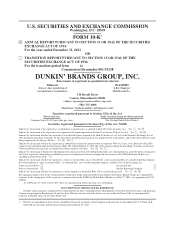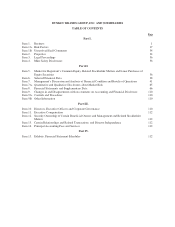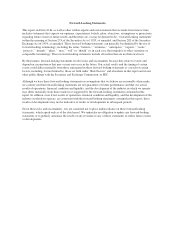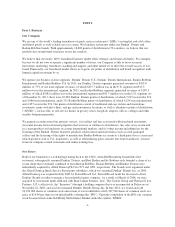Baskin Robbins 2011 Annual Report Download - page 18
Download and view the complete annual report
Please find page 18 of the 2011 Baskin Robbins annual report below. You can navigate through the pages in the report by either clicking on the pages listed below, or by using the keyword search tool below to find specific information within the annual report.Overview of franchising
Franchising is a business arrangement whereby a service organization, the franchisor, grants an operator, the
franchisee, a license to sell the franchisor’s products and services and use its system and trademarks in a given
area, with or without exclusivity. In the context of the restaurant industry, a franchisee pays the franchisor for its
concept, strategy, marketing, operating system, training, purchasing power and brand recognition.
Franchisee relationships
One of the ways by which we seek to maximize the alignment of our interests with those of our franchisees is by
not deriving additional income through serving as the supplier to our domestic franchisees. In addition, because
the ability to execute our strategy is dependent upon the strength of our relationships with our franchisees, we
maintain a multi-tiered advisory council system to foster an active dialogue with franchisees. The advisory
council system provides feedback and input on all major brand initiatives and is a source of timely information
on evolving consumer preferences, which assists new product introductions and advertising campaigns.
Unlike certain other QSR franchise systems, we generally do not guarantee our franchisees’ financing
obligations. As of December 31, 2011, if all of our outstanding guarantees of franchisee financing obligations
came due, we would be liable for $6.9 million. We intend to continue our past practice of limiting our guarantee
of financing for franchisees.
Franchise agreement terms
For each franchised restaurant, we enter into a franchise agreement covering a standard set of terms and
conditions. A prospective franchisee may elect to open either a single-branded distribution point or a multi-
branded distribution point. In addition, and depending upon the market, a franchisee may purchase the right to
open a franchised restaurant at one or multiple locations (via a store development agreement, or “SDA”). When
granting the right to operate a restaurant to a potential franchisee, we will generally evaluate the potential
franchisee’s prior food-service experience, history in managing profit and loss operations, financial history, and
available capital and financing. We also evaluate potential new franchisees based on financial measures,
including (for the smallest restaurant development commitment) a liquid asset minimum of $125,000 for the
Baskin-Robbins brand, a liquid asset minimum of $250,000 for the Dunkin’ Donuts brand, a net worth minimum
of $250,000 for the Baskin-Robbins brand, and a net worth minimum of $500,000 for the Dunkin’ Donuts brand.
The typical franchise agreement in the U.S. has a 20-year term. The majority of our franchisees have entered into
prime leases with a third-party landlord. When we sublease properties to franchisees, the sublease generally
follows the prime lease term structure. Our leases to franchisees are typically structured to provide a ten-year
term and two five-year options to renew.
We help domestic franchisees select sites and develop restaurants that conform to the physical specifications of
our typical restaurant. Each domestic franchisee is responsible for selecting a site, but must obtain site approval
from us based on accessibility, visibility, proximity to other restaurants, and targeted demographic factors
including population density and traffic patterns. Additionally, the franchisee must also refurbish and remodel
each restaurant periodically (typically every five and ten years, respectively).
We currently require each domestic franchisee’s managing owner and designated manager to complete initial and
ongoing training programs provided by us, including minimum periods of classroom and on-the-job training. We
monitor quality and endeavor to ensure compliance with our standards for restaurant operations through
restaurant visits in the U.S. In addition, a formal restaurant review is conducted throughout our domestic
operations at least once per year and comprises two separate restaurant visits. To complement these procedures,
we use “Guest Satisfaction Surveys” in the U.S. to assess customer satisfaction with restaurant operations, such
as product quality, restaurant cleanliness and customer service. Within each of our master franchisee and joint
-8-
























